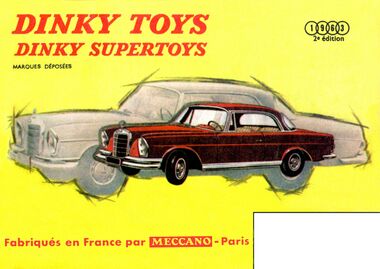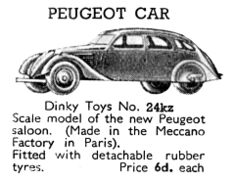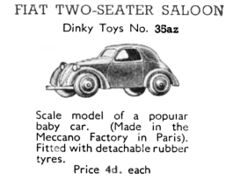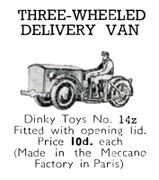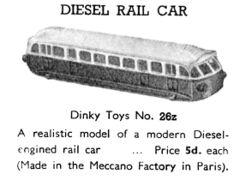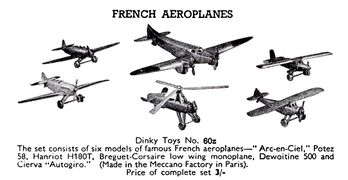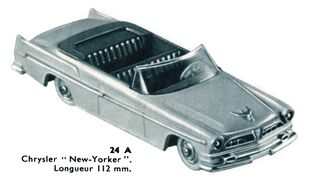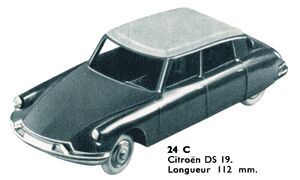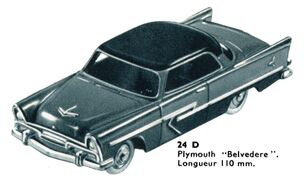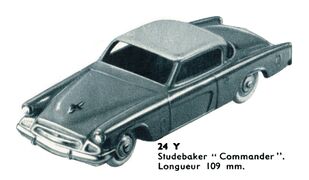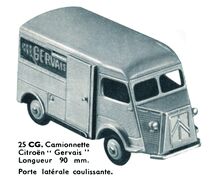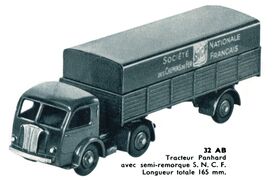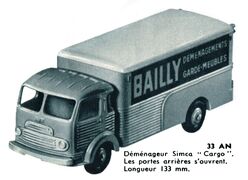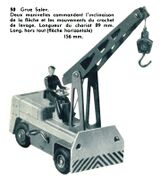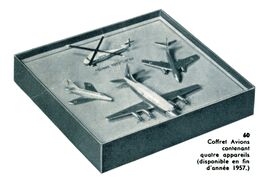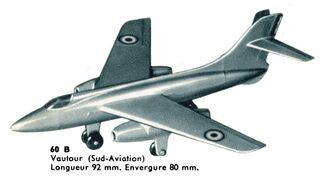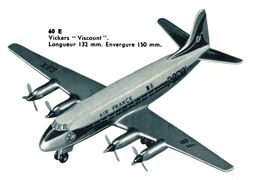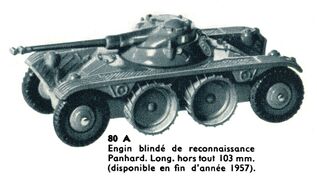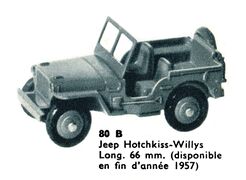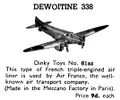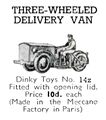Category:French Dinky Toys
Meccano/Hornby/Dinky :
Modelled Miniatures | Dinky Toys | Supertoys | Dinky Builder | Dublo Dinky |
Army | Boats | Dollhouse | Farm | Planes · 1 · 2 · 3 | Ships |
US FR 1930s | 1940s | 1950s | 1960s | 1970s |
| French marques |
|---|
| Charles Rossignol - Fournereau - Jouef - Jouet de Paris - Marescot | Meccano France French Dinky Toys - French Hornby |
1954: French Dinky Toys catalogue, front and back covers [image info]
1963: French Dinky Toys catalogue, front cover [image info]
1961: "Dinky Toys from Paris", full-page advert in Meccano Magazine [image info]
After Meccano France had solidified the Meccano brandname in France, it didn't take them long to start manufacturing locally. Initially, Meccano France started making Meccano (which was comparatively simple to produce) in Paris, but after the Bobigny plant was opened, this also became the company's manufacturing base for French Dinky Toys.
The local "Dinky" output usually modelled vehicles that were distinctly French or European. Where a UK buyer looking for a small diecast streamlined train would probably expect to find an "A4" ("Mallard-style") streamlined loco, their French counterpart would expect to be able to buy a model of a French diesel "autocar".
Some incorporations into the British range
Some of the French designs were so distinctively different to their British counterparts that they ended up being imported into the UK as official extensions of the main UK Dinky range. in the 1930s and early 1940s, these were usually marked with the suffix "z" added to their model numbers, to signify that they were French-produced, and to remove any numbering conflicts between the local UK-produced models and their French counterparts.
Some French "z" inclusions from the 1930s and WW2:
1954 article:
The MECCANO factory in Bobigny produces:
24 CARS PER MINUTEIt is, in fact, at the rate of four pieces every ten seconds that the "Dinky Toys" run off the production line. Every minute, twenty four “Arondes”, twenty four 2 CVs or twenty four “Vedettes”, examined, checked, tested, arrive in boxes of six at the end of the assembly belt.
And yet, you know enough about the models' fine reproduction and the fidelity to know that this level of output is not achieved at the expense of quality.
On the contrary, from the moment that a new "Dinky Toy" is "born", meticulous care oversees all research and stages of design.
When it has been decided to add a vehicle to the range of miniatures, the first step taken is a visit to the manufacturer, a visit which aims to obtain their authorisation as well as plans for the bodywork and possibly the chassis.
The artists in the design office study these documents, reduce them to the size of the "Dinky Toys" and draw up a plan which will make it possible to produce a meticulous model of the future vehicle in wood or plaster. The scale of this will vary from 1/43 to 1/49 in the case of passenger cars, and from 1/60 to 1/70 in the case of heavy goods vehicles.
After acceptance of the model – both by the manufacturer and by Meccano's management – the design office, whose task has only just begun, draws up the outline of the mould.
A "patern-maker", highly specialized in this long and delicate work, then manufactures the steel mold intended for the foundries. A mold is formed of at least two elements, which are bright into contact at the time of molding. Some models require very complicated moulds, the many skilfully interlocking parts of which are controlled by angled shafts. More than a thousand hours of work are needed to manufacture a mould. It is, in fact, on the mould, on its “tweaked” details, on its perfect adjustment, that the precision and the exceptional finesse of reproduction of the “Dinky Toys” depend. This is also what makes them successful.
The metal used to make miniatures is called “zamak”. It is an alloy that contains 99% zinc, manganese and aluminum. To be robust, it must be die-cast.
The mold is mounted in a furnace and the zamak, melted at a temperature of 450°, is automatically injected under a pressure of approximately 25 kilos per square centimeter, thanks to a jet of compressed air. The small cars come out of the foundry at a rate of 5 to 7 pieces per minute, depending on the model. They cool quickly and are sent to the "deburring" workshop.
Each car is then taken individually. Workers file or grind the sharp edges produced at the joints of the mould, polish the roofs, and check the quality of the casting.
More than 12,000 "Dinky Toys", as shiny as silver, pass through their hands every day. Any part with the slightest defect is automatically discarded and sent back to the melt with the shavings and scrap metal. They will once again become zamak ingots and the cycle will begin again...
After deburring the "Dinky Toys" are painted. They are placed on slatted trays and painted with a spray gun: the underside first, then they are turned over like waffles to paint the top. Details are added using stencils (grilles, headlights, bumpers) or with a brush (license plate and lights). The enamels used for the decoration of the "Dinky Toys" are dried in an oven, on a metal conveyor belt which passes through a long tunnel heated to 125°.
While the bodies are turned out of the moulds, and are deburred and painted, other workshops are also busy: the bases are stamped and formed, and blackened; tyres are fitted onto the wheels (nearly 50,000 are needed per day!); axles are mounted on the bases, the wheels onto the axles ...
And all these various operations take place at the proper time at the comencement of the last assembly line. All along the conveyor belt are machines: some rivet the bases, others crimp the wheels and the little cars arrive finished, fresh and mint, at the "test track." The word is not too strong to designate the inclined plane on which the "Dinky Toys" roll for the first time. A final check, which is also the most exacting, and each car is placed in the individual yellow box that you know well. Now no-one will touch it again until it reaches your hands.
The cases containing the "Dinky Toys" are grouped in sixes in cardboard boxes and these are directed to the warehouse where they do not stay for long. The warehouse supervisor sometimes has just enough time to count them before they go to the Shipping Department, which guarantees their packing and departure to your usual supplier.
Here, briefly outlined, is how we have already manufactured 550,000 lorries, 450,000 Peugeot 203s, 490,000 2CVs, 260,000 Arondes, etc.
Collectors' items as well as toys, "Dinky Toys" are becoming increasingly popular with enthusiasts of all ages. This success is undeniably based on the concern for quality, precision and detail on which Meccano prides itself. Collectors are well aware of this, recognising "Dinky Toys" at first glance, without even having to check that the words "Dinky Toys" and "Meccano" appear under the base.
— , A. M., , Meccano Magazine (France), , September 1954
1957 range:
1963 range:
from the 1963 French Dinky Toys catalogue, second edition
- 502 – Box matière plastique
- 503 – Coffret-cadeau Tourisme
- 511 – Ferrari
- 512 – Kart avec pilote
- 515 – Ferrari 250 GT "Super Détail"
- 517 – Renault "R8"
- 518 – Renault "4L"
- 519 – Simca 1000
- 520 – Fiat 600 D
- 521 – 403 Peugeot
- 522 – DS 19 Citroën
- 523 – Simca 1500
- 526 – Mercedes-Benz L – 90 SL
- 527 – Alfa-Romeo 1900
- 529 – 2CV Vespa 400
- 531 – Fiat L 200
- 532 – Lincoln "Premiere"
- 533 – Coupé Mercedes-Benz 300 SE
- 534 – B.M.W. 1500
- 535 – 2CV Citroën (modèle 1955)
- 538 – Ford Taunus Il M
- 539 – Break ID 19 Citroën "Super Détail"
- 540 – Opel "Kadett"
- 541 – Petit autocar Mercedes-Benz
- 543 – "Floride" Renault
- 544 – Simca Aronde P 60
- 545 – De Soto "Diplomat"
- 547 – Panhard PL17
- 548 – Fiat 1800 Familiale
- 549 – Borgward "Isabella"
- 550 – Chrysler "Saratoga"
- 552 – Chevrolet "Corvair"
- 553 – "404" Peugeot
- 554 – Opel "Rekord"
- 555 – Cabriolet Ford "Thunderbird"
- 556 – Ambulance Citroën ID 19 "Super Détail"
- 557 – "Ami 6" Citroën "Super Détail"
- 558 – 2CV Citroën (modèle 61)
- 559 – Ford "Taunus" 17 M
- 560 – Fourg.2 CV Citroën "Postes"
- 561 – Camionnette Citroën "Cibié"
- 562 – Fourg. 2 CV Citroën incendie
- 563 – Pick-up "Estafette" Renault
- 564 – Pick-up Renault miroitier
- 575 – Tracteur Panhard SNCF
- 576 – Tracteur Panhard Citerne
- 578 – Benne basculante Simca Cargo
- 579 – Miroitier Simca Cargo
- 580 – Berliet benne carrières
- 581 – Plateau Berliet avec container
- 582 – Dépanneuse Citroën
- 583 – Fourgon incendie Berliet
- 584 – Camion GAK Berliet bâché
- 585 – Camion GAK Berliet benne basc.
- 586 – Camion Laitier Citroën 55
- 590 – Signalisation ville
- 591 – Signalisation route
- 592 – Poste de ravitaillement
- 596 – Arroseuse-balayeuse
- 800 – Mystère IV A
- 801 – Vautour
- 804 – Noratlas
- 810 – Remorque bâchée
- 811 – Caravane
- 814 – AML Panhard
- 815 – EBR Panhard
- 816 – Jeep avec conducteur
- 817 – Char AMX 13 T
- 818 – Camion militaire Berliet tous terrains
- 819 – Obusier de 155 ABS
- 820 – Ambulance militaire
- 821 – Camion militaire "Unimog" Mercedes-Benz
- 822 – Half-Track M3 (avec mitrailleuse)
- 823 – Cuisine roulante
- 824 – Camion militaire Berliet "Gazelle"
- 825 – Camion militaire amphibie DUKW
- 826 – Camion militaire Berliet de dépannage
- 830 – Rouleau compresseur
DINKY SUPERTOYS
- 870 – Paquebot "France"
- 884 – Camion militaire Brockway avec pont
- 886 – Profileur 100 Richier
- 887 – Camion citerne UNIC "BP"
- 888 – Pétrolier GBO Berliet
- 890 – Berliet remorque porte-char
- 891 – Caravelle "Air France"
- 892 – "Super G" Constellation
- 893 – Tracteur UNIC Saharien porte-tubes
- 894 – Tracteur UNIC porte-voitures
- 895 – Camion Multibenne
- 896 – Tracteur Willème bâché
- 897 – Tracteur Willème fardier
- 898 – Tracteur Berliet porte-transfo
- 899 – Auto-échelle de pompiers
ACCESSOIRES
- 833 – Transfo, matière plastique
- 834 – Accessoires Brockway
- 835 – Gros pneus noirs (les 12)
- 836 – Gros pneus blancs (les 12)
- 837 – Petits pneus noirs (les 12)
- 838 – Petits pneus blancs (les 12)
- 840 – Elastiques pour échelle pompiers (les 10)
- 841 – Chenilles pour char AMX (les 10)
- 842 – Pneus pour Vespa (les L – 2)
- 843 – Pneus tous terrains (les 12)
- 844 – Tubes de pipe-line (les 6)
- 845 – Barrières, mat. plast. (les 10)
- 846 – Fûts mat. plast. (les 10)
- 847 – Tonneaux mat. plast. (les 10)
- 848 – Malles mat. plast. (les 10)
- 849 – Caisses mat. plast. (les 10)
- 850 – Casiers à bouteilles (les 10)
- 851 – Accessoires plastiques assortis
- 852 – Chenilles pour half-track (les 10)
- 853 – Pneus GBO et profileur (les L – 2)
- 854 – Casiers bouteilles de L – ait (les 10)
- 855 – Petits pneus noirs striés (les 12)
- 856 – Tourelle half-track
DINKY TOYS IMPORTES D'ANGLETERRE
- 142 L – Jaguar Mark X
- 150 L – Rolls Royce Silver Wraith
- 155 L – Ford "Anglia"
- 182 L – Coupé Porsche 356A
- 186 L – Mercedes-Benz 220 SE
- 189 L – Triumph Herald -
- 194 L – Coupé Bentley
- 195 L – Conduite int. Jaguar 3.4 l
- 198 L – Rolls Royce Phantom V (vitres ouvrantes)
- 199 L – Austin "Seven"
- 240 L – Voiture de course Cooper
- 241 L – Voiture de course Lotus
- 242 L – Voiture de course Ferrari
- 258 L – Voiture de police USA
- 263 L – Ambulance Criterion (arrière ouvrant)
- 276 L – Véhicule d'incendie d'aéroport (clignotant)
- 300 L – Tracteur agricole Massey Harris
- 320 L – Remorque agricole Halesowen
- 321 L – Epandeur d'engrais Massey Harris
- 324 L – Râteau àfoin
- 340 L – Land Rover
- 341 L – Remorque pour Land Rover
- 401 L – Chariot à fourche Coventry Climax
- 437 L – Chargeuse (camion de levage)
- 449 L – Pick-up El Camino Chevrolet
- 651 L – Char Centurion
- 661 L – Tracteur de dépannage
- 666 L – Fusée "Corporal"
- 667 L – Véhicule plateforme télescopique
- 697 L – Coffret d'artillerie
- 796 L – Canot Healey sur remorque
- 930 L – Camion Bedford avec palettes
- 958 L – Chasse-neige
- 960 L – Bétonnière sur camion
- 961 L – Bulldozer Blaw Knox
- 962 L – Basculeur automoteur Muir-Hill
- 964 L – Elévateur
- 965 L – Benne lourde Euclid
- 971 L – Grue mobile Coles
- 972 L – Camion-grue Coles 20 t
1965 article:
on the introduction to the UK of 516 Mercedes-Benz 230SL, 524 Panhard 24C, and 530 Citroen DS19
Three in the Continental Style
As many people know, Meccano Limited has a subsidiary company at Bobigny, near Paris. This company produces, among many other things, its own extensive range of Dinky Toys which are not normally available in Britain. However, we have obtained stocks of three outstanding Frrench-produced Dinky Toys which should appeal to all collectors and more especially to those enthusiasts, of whom there are a great number, who like to obtain as many varieties of Dinky Toys as they can.
Packed in the striking Dinky visi-pak, the new French Dinkies will be coming along shortly and will give collectors the chance to add a "Continental corner" to their layouts ...
— , Chris Jelley, , Meccano Magazine, , January 1965
1966 article:
Paris Potpourri
... Meccano Dinky Toys produced at their factory at Bobigny (Seine) France!
Before I start to waffle on about the cars, I'm going to stick my neck out and disagree (probably) with many and at the same time pay a compliment to everyone from designers to packers at the French factory. It's my considered and humble opinion that Meccano France produce the finest die-cast toys on the market (I don't own shares in the company!) I have in my collection some seventy different manufacturers' models including the Rio and Solido – which I love – and have seen most of the others, but Dinky France get my vote.
... One reason for this, is I thnk that before the war, Frank Hornby and all who worked for him, took a real pride in everything they produced. For example – take a pre-war R.A.C. man not an inch high. No flash, every detail nicely painted, face, eyes, hands, cap detail, etc., now, after the war due largely to rising costs we find station staff, etc., – to the same scale as the R.A.C. man – with one colour paint overall plus a too liberal dab of pink for face and hands. At the French factory I believe they've retained the old "Hornby attitude" and thanks to this, we have a fine range of models, with generally, a fine finish. ...
— , Ken Wooton, , Meccano Magazine, , October 1966
External links
Subcategories
This category has the following 4 subcategories, out of 4 total.
F
- French Aeroplanes (Dinky Toys 60z) (1 P, 1 F)
- French Aeroplanes (Dinky Toys 61z) (1 P, 1 F)
Pages in category ‘French Dinky Toys’
The following 2 pages are in this category, out of 2 total.
Media in category ‘French Dinky Toys’
The following 20 files are in this category, out of 20 total.
- Aeroplane Set, Dinky Toys Fr 60 (MCatFr 1957).jpg 3,000 × 2,023; 798 KB
- Amiot 370 monoplane, Dinky Toys 64az (MCat 1939).jpg 1,453 × 1,021; 131 KB
- Bloch 220 airliner, Dinky Toys 64bz (MCat 1939).jpg 1,481 × 801; 105 KB
- Dewoitine 338, Dinky Toys 61az (MeccanoCat 1939-40).jpg 1,069 × 887; 120 KB
- Diesel Rail Car, Dinky Toys 26z (MCat 1939).jpg 1,117 × 837; 93 KB
- Dinky Toys from Paris (MM 1961-05).jpg 968 × 1,200; 229 KB
- Dinky Toys, French catalogue, covers (1954).jpg 3,000 × 1,172; 597 KB
- Dinky Toys, French catalogue, front cover (1963-ed2).jpg 2,400 × 1,697; 572 KB
- Fiat Two-Seater Saloon, Dinky Toys 35az (MCat 1939).jpg 1,060 × 821; 91 KB
- French Aeroplanes, Dinky Toys 60z (MeccanoCat 1939-40).jpg 2,161 × 1,119; 241 KB
- French Aeroplanes, Dinky Toys 61z (MeccanoCat 1939-40).jpg 2,151 × 1,124; 245 KB
- French Meccano catalogue, covers (MCatFr 1957).jpg 3,000 × 999; 730 KB
- Lockheed Super G, Dinky Supertoys Fr 60 C (MCatFr 1957).jpg 3,000 × 1,896; 568 KB
- Mystere IV A (Marcel Dassault), Dinky Toys Fr 60A (MCatFr 1957).jpg 2,694 × 1,767; 440 KB
- Peugot Car, Dinky Toys 24kz (MCat 1939).jpg 956 × 735; 90 KB
- SikorskY S-58 Helicopter, Dinky Toys Fr 60 D (MCatFr 1957).jpg 3,000 × 1,601; 307 KB
- Streamlined Diesel Articulated Train, Dinky Toys 16z (MCat 1939).jpg 2,672 × 561; 143 KB
- Sud Aviation Vautour, Dinky Toys Fr 60 B (MCatFr 1957).jpg 3,000 × 1,680; 466 KB
- Three-Wheeled Delivery Van, Dinky Toys 14z (MC 1939).jpg 706 × 800; 61 KB
- Vickers Viscount, Dinky Toys Fr 60 E (MCatFr 1957).jpg 3,000 × 2,127; 577 KB

